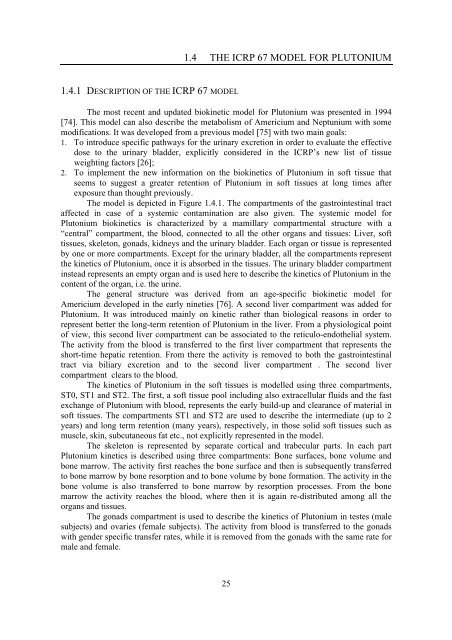Plutonium Biokinetics in Human Body A. Luciani - Kit-Bibliothek - FZK
Plutonium Biokinetics in Human Body A. Luciani - Kit-Bibliothek - FZK
Plutonium Biokinetics in Human Body A. Luciani - Kit-Bibliothek - FZK
Create successful ePaper yourself
Turn your PDF publications into a flip-book with our unique Google optimized e-Paper software.
1.4.1 DESCRIPTION OF THE ICRP 67 MODEL<br />
1.4 THE ICRP 67 MODEL FOR PLUTONIUM<br />
The most recent and updated biok<strong>in</strong>etic model for <strong>Plutonium</strong> was presented <strong>in</strong> 1994<br />
[74]. This model can also describe the metabolism of Americium and Neptunium with some<br />
modifications. It was developed from a previous model [75] with two ma<strong>in</strong> goals:<br />
1. To <strong>in</strong>troduce specific pathways for the ur<strong>in</strong>ary excretion <strong>in</strong> order to evaluate the effective<br />
dose to the ur<strong>in</strong>ary bladder, explicitly considered <strong>in</strong> the ICRP’s new list of tissue<br />
weight<strong>in</strong>g factors [26];<br />
2. To implement the new <strong>in</strong>formation on the biok<strong>in</strong>etics of <strong>Plutonium</strong> <strong>in</strong> soft tissue that<br />
seems to suggest a greater retention of <strong>Plutonium</strong> <strong>in</strong> soft tissues at long times after<br />
exposure than thought previously.<br />
The model is depicted <strong>in</strong> Figure 1.4.1. The compartments of the gastro<strong>in</strong>test<strong>in</strong>al tract<br />
affected <strong>in</strong> case of a systemic contam<strong>in</strong>ation are also given. The systemic model for<br />
<strong>Plutonium</strong> biok<strong>in</strong>etics is characterized by a mamillary compartmental structure with a<br />
“central” compartment, the blood, connected to all the other organs and tissues: Liver, soft<br />
tissues, skeleton, gonads, kidneys and the ur<strong>in</strong>ary bladder. Each organ or tissue is represented<br />
by one or more compartments. Except for the ur<strong>in</strong>ary bladder, all the compartments represent<br />
the k<strong>in</strong>etics of <strong>Plutonium</strong>, once it is absorbed <strong>in</strong> the tissues. The ur<strong>in</strong>ary bladder compartment<br />
<strong>in</strong>stead represents an empty organ and is used here to describe the k<strong>in</strong>etics of <strong>Plutonium</strong> <strong>in</strong> the<br />
content of the organ, i.e. the ur<strong>in</strong>e.<br />
The general structure was derived from an age-specific biok<strong>in</strong>etic model for<br />
Americium developed <strong>in</strong> the early n<strong>in</strong>eties [76]. A second liver compartment was added for<br />
<strong>Plutonium</strong>. It was <strong>in</strong>troduced ma<strong>in</strong>ly on k<strong>in</strong>etic rather than biological reasons <strong>in</strong> order to<br />
represent better the long-term retention of <strong>Plutonium</strong> <strong>in</strong> the liver. From a physiological po<strong>in</strong>t<br />
of view, this second liver compartment can be associated to the reticulo-endothelial system.<br />
The activity from the blood is transferred to the first liver compartment that represents the<br />
short-time hepatic retention. From there the activity is removed to both the gastro<strong>in</strong>test<strong>in</strong>al<br />
tract via biliary excretion and to the second liver compartment . The second liver<br />
compartment clears to the blood.<br />
The k<strong>in</strong>etics of <strong>Plutonium</strong> <strong>in</strong> the soft tissues is modelled us<strong>in</strong>g three compartments,<br />
ST0, ST1 and ST2. The first, a soft tissue pool <strong>in</strong>clud<strong>in</strong>g also extracellular fluids and the fast<br />
exchange of <strong>Plutonium</strong> with blood, represents the early build-up and clearance of material <strong>in</strong><br />
soft tissues. The compartments ST1 and ST2 are used to describe the <strong>in</strong>termediate (up to 2<br />
years) and long term retention (many years), respectively, <strong>in</strong> those solid soft tissues such as<br />
muscle, sk<strong>in</strong>, subcutaneous fat etc., not explicitly represented <strong>in</strong> the model.<br />
The skeleton is represented by separate cortical and trabecular parts. In each part<br />
<strong>Plutonium</strong> k<strong>in</strong>etics is described us<strong>in</strong>g three compartments: Bone surfaces, bone volume and<br />
bone marrow. The activity first reaches the bone surface and then is subsequently transferred<br />
to bone marrow by bone resorption and to bone volume by bone formation. The activity <strong>in</strong> the<br />
bone volume is also transferred to bone marrow by resorption processes. From the bone<br />
marrow the activity reaches the blood, where then it is aga<strong>in</strong> re-distributed among all the<br />
organs and tissues.<br />
The gonads compartment is used to describe the k<strong>in</strong>etics of <strong>Plutonium</strong> <strong>in</strong> testes (male<br />
subjects) and ovaries (female subjects). The activity from blood is transferred to the gonads<br />
with gender specific transfer rates, while it is removed from the gonads with the same rate for<br />
male and female.<br />
25












![{A1[]Sp - Bibliothek](https://img.yumpu.com/21908054/1/184x260/a1sp-bibliothek.jpg?quality=85)




